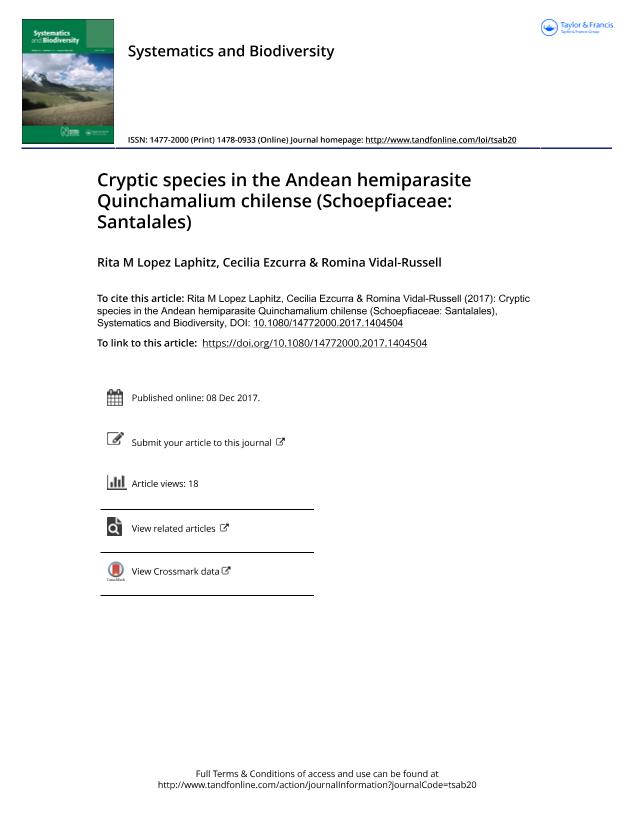Artículo
Cryptic species in the Andean hemiparasite Quinchamalium chilense (Schoepfiaceae: Santalales)
Fecha de publicación:
04/2018
Editorial:
Cambridge University Press
Revista:
Systematics And Biodiversity
ISSN:
1477-2000
Idioma:
Inglés
Tipo de recurso:
Artículo publicado
Clasificación temática:
Resumen
The integration of different characters (e.g. morphological, ecological, and molecular) is now recognized as important in species delimitation. In particular, genetic distances between homologous genes have been suggested as one of the main tools to identify species, especially in the case of cryptic species. Quinchamalium is morphologically variable and occupies a diverse set of biomes across its distribution in the Southern Andes. Recent work based on morphology has synonymized the entire genus as a single morphospecies, Quinchamalium chilense. This widely distributed taxon presents the opportunity to find potential cryptic species. The main objective of this study was to test the existence of cryptic species, based mainly on phylogenetic gene trees, genetic distances, and geographic patterns of haplotypes from molecular markers of the nuclear (ITS) and chloroplast (trnL-F) genomes, considering climatic and morphological characteristics. The ITS phylogeny and corresponding haplotype network resulted in three lineages with strong genetic differentiation and distinct geographic patterns. These lineages were informally named Desert, Matorral, and Mountain, based on their geographic distribution in different biomes. The trnL-F chloroplast phylogeny did not distinguish Desert from Matorral, and the haplotype network showed overlap between these last two lineages. Overall, we hypothesize the existence of two cryptic species within Quinchamalium chilense (Mountain and Matorral–Desert) that correspond to genetic, climatic, and morphological differences.
Archivos asociados
Licencia
Identificadores
Colecciones
Articulos(INIBIOMA)
Articulos de INST. DE INVEST.EN BIODIVERSIDAD Y MEDIOAMBIENTE
Articulos de INST. DE INVEST.EN BIODIVERSIDAD Y MEDIOAMBIENTE
Citación
Lopez Laphitz, Rita Maria; Ezcurra, Cecilia; Vidal Russell, Romina; Cryptic species in the Andean hemiparasite Quinchamalium chilense (Schoepfiaceae: Santalales); Cambridge University Press; Systematics And Biodiversity; 16; 3; 4-2018; 260-270
Compartir
Altmétricas




